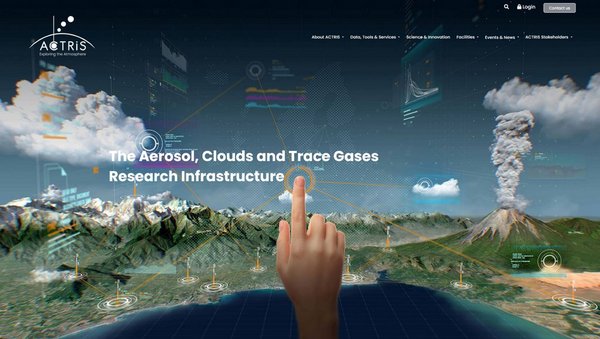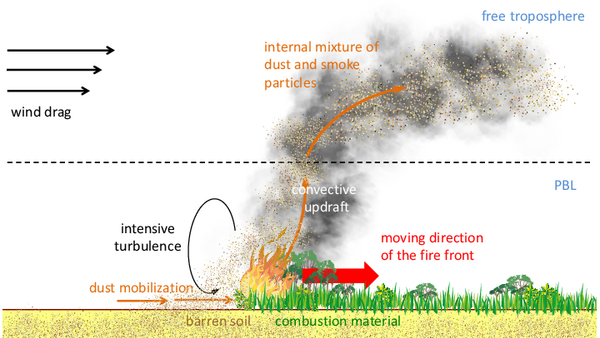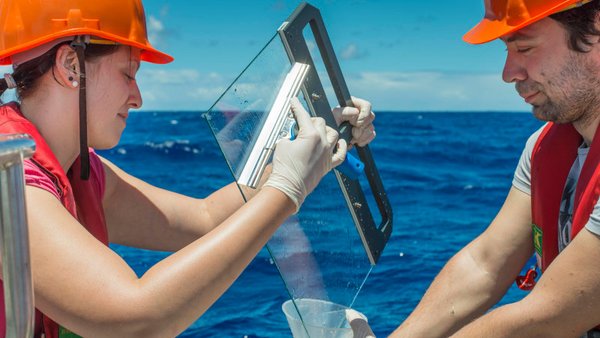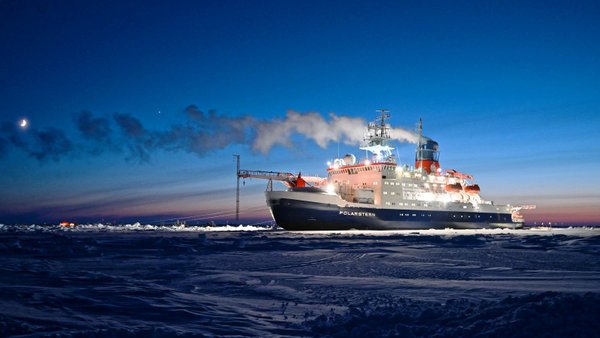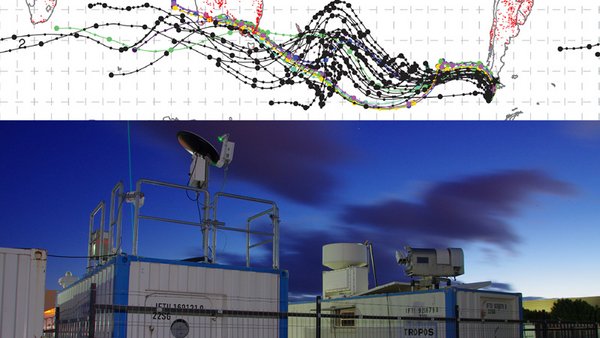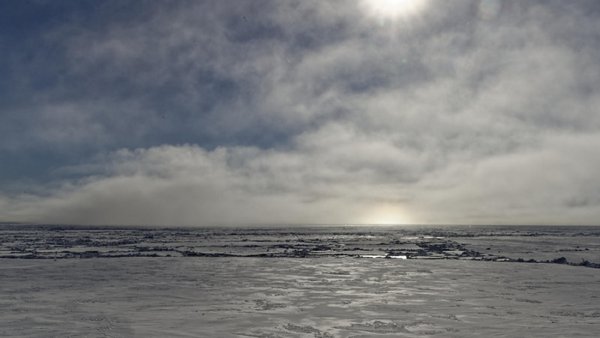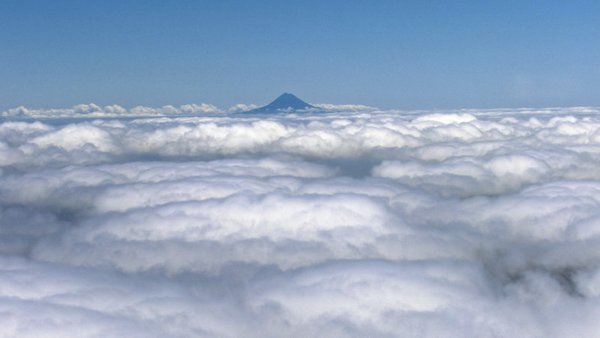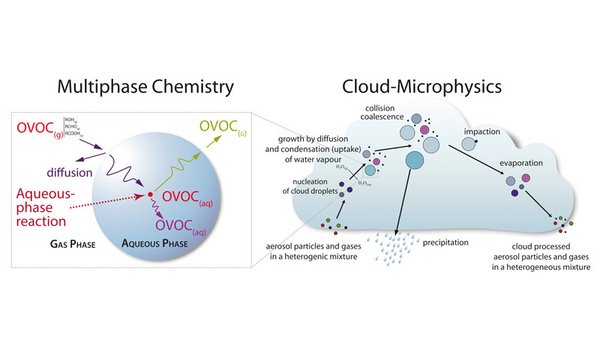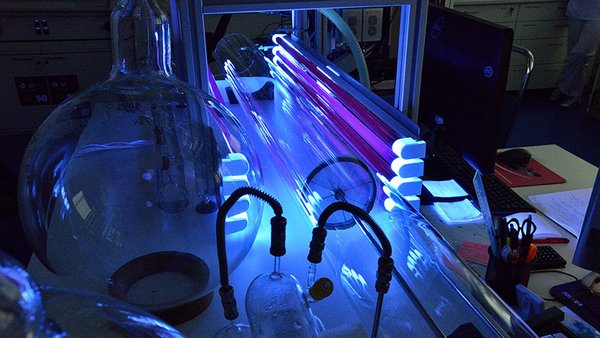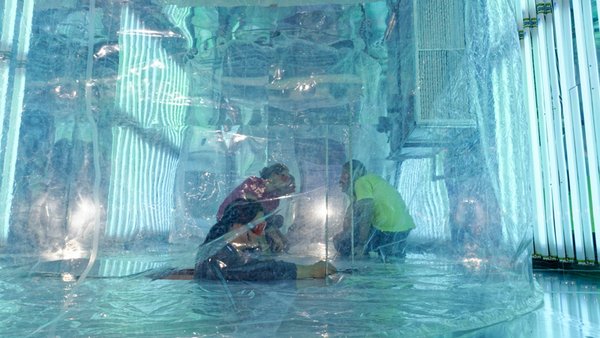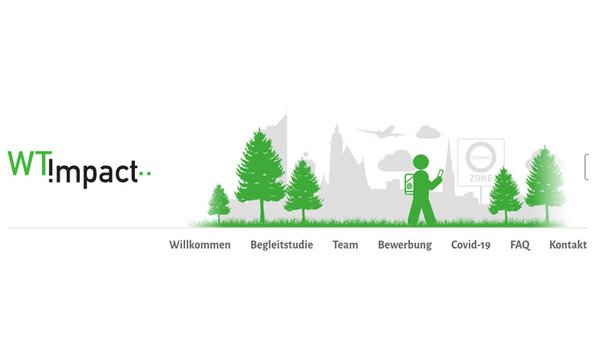Highlights 2015-2021
As part of the evaluation process, TROPOS has defined highlights for the years 2015 to 2021 from research, infrastructure and transfer, which we would like to present to you:
Infrastructure:
ACTRIS-D: The establishment of ACTRIS-D, the German contribution to the European Aerosol, Clouds and Trace Gases Research Infrastructure, under the lead of TROPOS is a top achievement. In 2015, TROPOS initiated the proposal for the German Roadmap for Research Infrastructures, to which ACTRIS-D was adopted in September 2019. During an 8-year implementation phase from 2021-2029, the ACTRIS-D consortium consisting of 11 German institutions is supported with 86 Mio. Euro by the Federal Ministry of Education and Research. About 25 Mio. Euro will be invested to upgrade or newly establish TROPOS research facilities - observation sites, mobile platforms, atmospheric simulation chambers, and calibration laboratories. This big effort will allow TROPOS to strengthen its leading role in the research field of aerosol and clouds at national and international level and to perform front-line atmospheric research over the next decades.
TROPOS has substantially contributed to establishing ACTRIS at the European level. ACTRIS became part of the ESFRI Roadmap for Research Infrastructures in 2016 and will function as a European Research Infrastructure Consortium (ERIC) starting in 2022. TROPOS has taken the lead for developing the strategy, guidelines, and labelling process for ACTRIS National Facilities (i.e., the European network of stations, simulation chambers, and mobile platforms) and has been strongly involved in defining the role of the ACTRIS Central Facilities (i.e., the common calibration and data centres). Based on the experience and success of the World Calibration Centre for Aerosol Physics (WCCAP) hosted by the Institute since 2002 (Wiedensohler et al., 2018), TROPOS is leading the implementation of the European Centre for Aerosol Calibration, one of the six ACTRIS Topical Centres.
Several TROPOS facilities have contributed to ACTRIS already for a long time, and the Institute’s continuing development efforts help improve the infrastructure’s research capacities. As part of EUROCHAMP-2020, which is being integrated into ACTRIS, the atmospheric simulation chambers ACD-C and LACIS-T have demonstrated their attractiveness through the provision of transnational access to external users, thus increasingly fostering international collaboration and strengthening scientific outcome. At the Research Station Melpitz, a core site for investigating long-term atmospheric developments in the centre of the European continent, new measurement methods for particle and gas-phase chemical characterization have been established and qualified for the implementation into the ACTRIS observational network (Stieger et al., 2019; Poulain et al., 2020), and first multi-year results could be achieved (Stieger et al., 2018, 2021). With its fully automated PollyNET lidar stations (Engelmann et al., 2016), TROPOS now sets the standard in ACTRIS for continuous aerosol remote-sensing observations with near-real-time data provision. The network was successfully used for the validation of aerosol products from Aeolus, the first European and first high-spectral-resolution lidar in space (Baars et al., 2020).
Mineral dust in the “Dust Belt”
Over the last two decades, TROPOS has developed strong expertise on mineral dust aerosol, the processes which determine its atmospheric distribution, and its effects on the Earth radiation balance and on ice formation in mixed-phase clouds. Following the highly successful series of field measurements and modelling studies that focused on the dust outflow from the western Sahara across the Atlantic (Haarig et al., 2019), a new focus was set to cover the dust belt eastwards, from the tropical Atlantic across the Mediterranean Sea to Central Asia. A unique site was established in Dushanbe (Tajikistan) for long-term profiling of aerosol properties in a region strongly affected by climate change (Hofer et al., 2020), where for the first time dust profiles were detected, reaching up to cirrus level. Considerable differences in vertical dust distribution, optical properties, and ice formation were found between the Eastern and Western parts of the dust belt.
New chemical analytical methods to determine the chemical composition of mineral dust, including its heavy-metal content (Fomba et al., 2018), led to identification of dust chemical footprints using elemental ratios and isotope signatures (Kumar et al., 2018). Results elucidate the seasonal variation of Saharan dust transport, the deposition of dust-related trace elements, the contribution of mineral dust to air pollution, and its role on marine cloud formation.
The model-based understanding of the mineral dust cycle has been improved through diverse and extensive studies of atmosphere-surface interactions, leading to the development of a new parameterization for dust emission via fire-induced pyro-convection (Wagner et al., 2018, 2021) and for fluvial deposits, which are now being implemented in large-scale atmospheric models. Atmospheric aerosol model simulations of synthetic infrared images showed that the dust index provided by MSG SEVIRI (Meteosat Second Generation Spinning Enhanced Visible and InfraRed Imager) is only sensitive to low-level dust for dry and hot conditions (Banks et al., 2019).
Highlight publication:
Wagner, R., Jähn, M. and Schepanski, K. 2018. Wildfires as a source of airborne mineral dust – revisiting a conceptual model using large-eddy simulation (LES). Atmos. Chem. Phys., 18, 11863-11884. https://doi.org/10.5194/acp-18-11863-2018.
Ocean-atmosphere interactions
Since 2015, TROPOS has enhanced its research portfolio in particular with respect to marine and polar environments. The topic of ocean-atmosphere interactions has extensively been investigated within various marine field campaigns and was combined with the development and application of innovative sampling and analytical methods (Huang et al., 2017; van Pinxteren et al., 2020; Zeppenfeld et al., 2021). Intensive studies focused on the role of the upper layer of the ocean (sea-surface microlayer, SML) have shown that this thin oceanic layer may play a driving role in the the enrichment of important organic-matter compounds (van Pinxteren et al., 2020; Triesch et al., 2021). The potentially large influence of microbiological processes on the SML and on aerosol particle properties and composition was also emphazised (Zeppenfeld et al., 2021).
Detailed box model simulations have been carried out to study the chemical multiphase processing of dimethyl sulfide (DMS), indicating that DMS multiphase chemistry increases aerosol particle mass, but not necessarily the aerosol particle number. Accordingly, the CCN number concentration over the ocean can be lower than suggested in current models which is therefore similarly true for cloud albedo and corresponding effects on natural radiative forcing (Hoffmann et al., 2016).
Linkages between the chemical composition and microphysical properties have been revealed. The simple sugar glucose may serve as a biological tracer for ice nucleating particles (INP), connected to biogeochemical processes in the SML (Zeppenfeld et al., 2019). The recent studies provide a wide information about the concentration and composition of atmospheric-relevant organic matter components in the diverse marine compartments (seawater, aerosol particle, cloud water) for the first time. Comparing concentrations of INP in ocean and SML with those in the marine atmosphere (both in the tropical Atlantic and in the Arctic Ocean) shows that airborne concentrations cannot be explained by sea spray emissions unless a strong enrichment of INP during the bubble bursting process would occur (Gong et al., 2020; Hartmann et al., 2021).
Modelling of wind-driven emissions of primary marine particles containing both sea salt and organic components at regional and global scales was evaluated with field measurements (van Pinxteren et al., 2020). It was shown that taking into account the temperature dependence of primary particle emissions significantly improves the emission parameterisation compared to measurements. A model parameterisation of potentially ice-active components such as marine sugars is currently in progress.
Highlight publication:
Hoffmann, E. H., Tilgner, A., Schrödner, R., Bräuer, P., Wolke, R. and Herrmann, H. 2016. An advanced modelling study on the impacts and atmospheric implications of multiphase dimethyl sulfide chemistry. Proc. Nat. Acad. Sci. (PNAS), 113, 11776–11781. https://doi.org/10.1073/pnas.1606320113.
Polar regions
As a straightforward and logical scientific development, TROPOS extended the marine research activities to the polar region, to investigate aerosol and aerosol-cloud interaction in the dramatically warming Arctic and in the so far underexplored Antarctic. Both regions are characterized by strong marine productivity with little understood but potentially huge consequences for biogenically influcenced marine aerosol, its role in cloud formation and radiative forcing, as the current discussion in literature shows.
As a strong partner in both the DFG priority program “Arctic Amplification: Climate Relevant Atmospheric and Surface Processes and Feedbacks, (AC)3” and in the international polar drift expedition MOSAiC (Multidisciplinary drifting Observatory for the Study of Arctic Climate), TROPOS provided significant contributions for a better understanding of a changing Arctic. Earlier near-surface observations by TROPOS are now being extended into the vertical using tethered balloons and active remote sensing. This approach enabled to address a broader range of scientific questions. For instance, it was found that the feeding of stratiform boundary-layer clouds with moisture provides an explanation of their longevity (Egerer, 2021).
During the PASCAL (Physical feedbacks of Arctic PBL, Sea ice, Cloud And Aerosol) and the MOSAiC campaigns, the OCEANET remote-sensing platform conducted continuous observations (Griesche et al., 2020) and provided inimitable insights into processes related to Arctic haze, wildfire smoke, and ice formation (Engelmann et al., 2021). It was found that the Arctic atmosphere considerably suffered from Siberian Forest fires in the summer of 2019. Smoke layers were detected in the upper troposphere/lower stratosphere (UT/LS) near the North Pole throughout the winter season of 2019/20 and possibly contributed to the record-breaking ozone depletion observed in parallel (Ohneiser et al., 2021). The profile observations were accompanied by high-resolution radiation and meteorological measurements to better understand processes associated with current climate change in the Arctic. For the first time, characteristic small-scale spatiotemporal variability of global irradiance on an ice floe could be related to specific cloud types with a dense network of autonomous pyranometers (Barrientos et al., 2020).
For INP in polar regions, it was described for the first time that a strong annual variation exists with high concentrations of biological, highly ice active INP in the Arctic summer (Wex et al., 2019). While INP sources are generally difficult to determine, a strong local marine source was found over open leads and polynyas (Hartmann et al., 2020).
The Southern Hemispheric polar region is vulnerable to climate change and underexplored in terms of natural and anthropogenic aerosol distributions as well as aerosol-cloud interaction. TROPOS significantly contributed to the Antarctic Circumnavigation Expedition (ACE) of the Swiss Polar Institute (Welti et al., 2020) and is engaged in the Antarctic and Southern Ocean research in the framework of the DFG priority programme “Antarctic Research with Comparative Investigations in Arctic Ice Areas”. Aerosol measurements including cloud condensation nuclei (CCN) and INP in pristine environments are important for a process understanding and are extremely valuable as model constraints. Aerosol size distributions with a dominant Aitken mode were observed and indicate secondary particle formation in the Southern Ocean upper troposphere as a source of aerosol particles in East Antarctica (Herenz et al., 2019).
Highlight publication:
Engelmann, R., Ansmann, A., Ohneiser, K., Griesche, H., Radenz, M., Hofer, J., Althausen, D., Dahlke, S., Maturilli, M., Veselovskii, I., Jimenez, C., Wiesen, R., Baars, H., Bühl, J., Gebauer, H., Haarig, M., Seifert, P., Wandinger, U. and Macke, A. 2021. Wildfire smoke, Arctic haze, and aerosol effects on mixed-phase and cirrus clouds over the North Pole region during MOSAiC: An introduction. Atmos. Chem. Phys., 21, 13397-13423. https://doi.org/10.5194/acp-21-13397-2021.
Biomass-burning smoke
In recent years, the aerosol burden related to biomass-burning smoke from wildfires has substantially increased. This development triggered a new research focus on the distribution, physical and chemical properties, transport processes, and climate effects of smoke aerosol. Unprecedented amounts of smoke caused by biomass burning have been observed with lidar in the Northern and Southern Hemispheres since 2017. Increased wildfire activity in conjunction with big pyrocumulonimbus events led to long-term perturbations of the stratosphere. Smoke injected by fires in North America in the summer of 2017 was observed with TROPOS’ automated lidar network over Europe for more than half a year (Baars et al., 2019). The tremendous Australian bushfires in January 2020 caused aerosol layers rising up to heights of around 30 km, as observed by the LACROS station at Punta Arenas, Chile (Ohneiser et al., 2020). The aerosol remained in the Southern Hemispheric stratosphere for more than one year and caused a massive perturbation in the radiation balance (Heinold et al., 2021).
In the context of the smoke observations in the Southern and Northern Hemispheres, previously unknown processes such as radiative lifting of aerosol layers into the stratosphere were documented and verified with model studies. The high concentrations and thick coatings of biomass-burning smoke particles observed with the IAGOS-CARIBIC aircraft emphasize that the smoke can induce strong local heating in the lowermost stratosphere and may have a significant influence on the regional radiative forcing of climate (Ditas et al., 2018). The previously non-existing smoke particles in these height ranges may influence stratospheric ozone chemistry and enhance the INP reservoir of the UT/LS (Ohneiser et al., 2021). In order to further study the complex processes related to smoke aerosol, an extensive series of kinetic measurements of compounds emitted from biomass burning is being undertaken at ACD-C with the aim to construct a dedicated multiphase mechanism for a better modelling of biomass burning and its effects on the atmosphere.
Highlight publication:
Ohneiser, K., Ansmann, A., Baars, H., Seifert, P., Barja, B., Jimenez, C., Radenz, M., Teisseire, A., Floutsi, A., Haarig, M., Foth, A., Chudnovsky, A., Engelmann, R., Zamorano, F., Bühl, J. and Wandinger, U. 2020. Smoke of extreme Australian bushfires observed in the stratosphere over Punta Arenas, Chile, in January 2020: Optical thickness, lidar ratios, and depolarization ratios at 355 and 532 nm. Atmos. Chem. Phys., 20, 8003-80015. https://doi.org/10.5194/acp-20-8003-2020.
Mixed-phase clouds
Research on physical aerosol-cloud interaction has gained increasing importance in the Institute’s research portfolio over the last decade. Great effort has been put into improved observation techniques, new methodologies, and experimental studies. In the laboratory, cloud-aerosol interaction can now be investigated under turbulent conditions in the precise thermodynamically controlled setup of LACIS-T. In first experiments, clear indications of the influence of turbulent relative-humidity fluctuations on particle deliquescence and droplet formation were found (Niedermeier et al., 2020).
New remote-sensing instrumentation and its consequent synergistic use have led to new insights into ice-formation processes in mixed-phase and cirrus clouds. For the first time, closure between the INP number concentration in the vicinity of the clouds and the number of ice crystals formed inside the cloud was achieved with novel lidar-radar techniques (Ansmann et al., 2019; Bühl et al., 2019) and the contrasting behaviour of ice-containing clouds under pristine and polluted conditions could be shown (Radenz et al., 2021). Successful closure - in the case of mixed-phase clouds as well as cirrus - means that aerosol particles control the evolution of ice crystals in the observed cloud systems. In contradiction to prevalent models, which postulate the dominance of homogeneous freezing, TROPOS measurements show that heterogeneous ice-nucleating processes play an important role for cirrus formation in dusty and smoke-laden environments (Weger et al., 2018; Ansmann et al., 2019; Engelmann et al., 2021). In this context, also aircraft measurements performed in the framework of IAGOS-CARIBIC showed that volcanic aerosol particles from the stratosphere seed the upper troposphere and lead to changes of the optical properties of cirrus clouds (Friberg et al., 2015).
Additionally, new off-line techniques for the determination of INP concentrations were intensively used, yielding results about INP in remote environments such as the Arctic (Hartmann et al, 2019, Wex et al., 2019), the Southern Ocean (Welti et al., 2020), or the outflow region of the Saharan desert (Gong et al., 2020), but also in highly polluted areas such as Beijing (Chen et al., 2018). It was clearly seen that anthropogenic pollution generally did not contribute INP active in the mixed-phase cloud regime. Also, for the first time, we found that Arctic INP concentrations did not increase during the past centuries prior to 1990 (Hartmann et al., 2019).
Highlight publication:
Hartmann, M., Blunier, T., Brügger, S. O., Schmale, J., Schwikowski, M., Vogel, A., Wex, H. and Stratmann, F. 2019. Variation of ice nucleating particles in the European Arctic over the last centuries. Geophys. Res. Lett., 46, https://doi.org/10.1029/2019GL082311.
Warm clouds
The relationship between cloud droplet number concentration in pure liquid-water clouds and the number of cloud condensation nuclei (CCN) below cloud base was systematically studied with a newly developed lidar technique. In this way, the aerosol-cloud-interaction index quantifying the Twomey effect could be determined in contrasting clean and polluted environments (Jimenez et al., 2020, 2020).
The helicopter-borne platform Airborne Cloud Turbulence Observation System (ACTOS) was used for the first time to measure typical fluctuations in the moisture field during the onset of cumulus convection (Siebert et al., 2020). High fluctuations in super-saturation could plausibly explain the appearance of large cloud droplets already at this early cloud stage and provide new insight into droplet activation (Siebert and Shaw, 2017). With the high-resolution ACTOS measurements, it was further shown on small scales that warm clouds can also contribute to the formation of new particles (Wehner et al., 2015).
Online in-situ measurements of CCN from remote areas such as the Southern Ocean were found to be extremely valuable to constrain global models with respect to radiative forcing due to aerosol-cloud interaction (Regayre et al., 2020).
Highlight publication:
Siebert, H. and Shaw, R. A. 2017. Supersaturation fluctuations during the early stage of cumulus formation. J. Atmos. Sci., 74, 975-988. https://doi.org/10.1175/JAS-D-16-0115.1.
Multiphase chemistry
Combined laboratory, field, and modelling studies on tropospheric multiphase chemistry represent a central research topic and key expertise of TROPOS. Here, several comprehensive and highly-cited literature reviews on (i) tropospheric multiphase chemistry processes (Herrmann et al., 2015), (ii) tropospheric NO3 radical chemistry of BVOCs (Ng et al., 2017) and (iii) the impact of acidity of particles and clouds (Pye et al., 2020; Tilgner et al., 2021) were compiled providing both a broad overview and perspectives for future research.
In aqueous-phase laboratory studies, further refinement of the competition kinetics of radical-driven oxidative degradation reactions was established, based on the state-of-the-art laser flash photolysis system. In this way, the oxidation of terpene-derived acids by atmospherically relevant radicals could be examined. The reaction behaviour of photosensitizers in the aqueous phase has been intensively studied and has clarified their role in the aerosol phase (Felber et al., 2020; 2021).
Multiphase chemical mechanisms resulting from laboratory measurements have been continuously developed and applied during process modelling for realistic atmospheric conditions to investigate their impacts on air quality and climate. The first automated CAPRAM–GECKO mechanism generator and a new CAPRAM core mechanism (CAPRAM4.0) have been constructed and applied in process model studies, which showed substantial impacts of the organic chemistry on the budget of radical oxidants and secondary organic compounds. For marine aerosol chemistry, a newly recognised DMS reaction pathway, extended by MSA reactions in the aqueous phase, were implemented in reduced form in the regional COSMO-MUSCAT and global ECHAM-HAMMOZ models (Hoffmann et al., 2020; Hoffmann et al., 2016). The results show the important role of multiphase DMS oxidation on SO2, MSA, and nss-sulfate, with direct impacts on climate through new particle formation and CCN activation. Furthermore, a newly developed mechanism describing the complex multiphase chemistry of reactive halogen compounds was applied to investigate the influence on air quality at polluted coastlines. The simulations revealed that the interaction of reactive halogen compounds with NOx is crucial when determining NOx and SOA concentrations. Other investigations demonstrated the key role of multiphase chemistry for the tropospheric formation and fate of substituted aromatic compounds and their impact on brown carbon.
Highlight publication:
Herrmann, H., Schaefer, T., Tilgner, A., Styler, S. A., Weller, C., Teich, M. and Otto, T. 2015. Tropospheric aqueous-phase chemistry: Kinetics, mechanisms, and its coupling to a changing gas phase. Chem. Rev., 115, 4259-4334. https://doi.org/10.1021/cr500447k.
Gas-phase chemistry
In the field of gas-phase chemistry, based on the state-of-the-art flow system and latest mass spectrometric techniques, a more direct insight into atmospheric oxidation processes became possible mainly due to direct monitoring of reactive intermediates like Criegee Intermediates (Berndt et al, 2017) and RO2 radicals (Berndt et al., 2016; Berndt et al., 2018). Detection limits down at 104 molecules cm-3, i.e., below ppq level (parts per quadrillion, 10-15), allow investigations on atmospherically relevant concentration levels, overcoming the flaws in mechanistic studies of the past. Hence, in collaboration especially with experts from quantum chemistry, a series of novel gas-phase processes has been discovered, such as the daytime-HOM formation from the OH + terpene reaction (Berndt et al., 2016) or the formation of accretion products ROOR´ from the RO2 + R´O2 reaction (Berndt et al., 2018). As recently reviewed, the observed HOMs and ROOR´ products are important for SOA formation (Bianchi et al., 2019), with important contributions made by TROPOS. Moreover, new reaction pathways from the OH radical-initiated degradation of dimethyl sulfide (DMS) and dimethyl disulfide (DMDS) have been discovered as being important for the formation of sulfuric acid and methanesulfonic acid. Especially sulfuric acid represents a major precursor substance for atmospheric nucleation. Direct monitoring of the simplest Criegee Intermediate, CH2OO, from the ozonolysis of ethylene under atmospheric conditions became possible for the first time. Kinetic measurements confirmed CH2OO´s gas-phase reactivity in the atmosphere (Berndt et al., 2017). A TROPOS contribution supported the mechanistic understanding of new particle formation on molecular level relevant in iodine-rich areas (Sipilä et al., 2016).
Highlight publication:
Berndt, T., Herrmann, H. and Kurten, T. 2017. Direct probing of Criegee intermediates from gas-phase ozonolysis using chemical ionization mass spectrometry. J. Amer. Chem. Soc., 139, 13387-13392. https://doi.org/10.1021/jacs.7b05849.
Secondary organic matter
Secondary organic matter is one of the most abundant, but least understood components of atmospheric particles. A newly developed method combining liquid-phase fractionation with ultrahigh-resolution mass spectrometry allowed for unprecedented insights into the vast molecular diversity of these organic compounds (Spranger et al., 2019). Among them, highly oxidized organic molecules (HOMs) have been identified for the first time in the particle phase after transfer from the gas phase (Mutzel et al., 2015) and highly oxidized organosulfates were found to be likely formed in the aqueous phase (Mutzel et al., 2015). Current knowledge on formation, abundance, fate, and significance of organosulfates as important SOA constituents has been reviewed and summarized for the first time (Brüggemann et al., 2020). For continental aerosol, a kinetic approach for modelling SOA formation considering particle size and viscosity was developed, evaluated by chamber measurements, and applied for Central Europe (Gatzsche et al., 2017).
Highlight publication:
Gatzsche, K., Iinuma, Y., Tilgner, A., Mutzel, A., Berndt, T. and Wolke, R. 2017. Kinetic modeling studies of SOA formation from α-pinene ozonolysis. Atmos. Chem. Phys., 17, 13187-13211. https://doi.org/10.5194/acp-2017-275.
Air quality and health
TROPOS has developed world-leading standards in high-quality measurements of aerosol microphysical properties that are applied in numerous studies on air quality and health in Germany and worldwide. The “TROPOS aerosol backpacks” were created for mapping pollutant concentrations in urban areas (Manila, Rome, La Paz, Leipzig, Dresden etc.) and determining personal exposure, but also led to the creation of recommendations for high-quality mobile measurements suited for scientific investigations (Alas et al., 2019) and to citizen participation in air-pollution mapping. TROPOS and partners from the Leibniz Association have developed new transfer tools to raise public awareness of the concept of air quality, causes of air pollution and their health impacts. These include a series of mobile and easy-to-use backpacks for PM10 and soot measurements, a novel approach for highly efficient, high-resolution air quality modelling and a user platform for further analysis and exchange with scientists at TROPOS.
The mobile measurements have been extended to investigate respiratory tract deposition dose (RDD) in different microenvironments (Madueno et al., 2020) and the effects of different factors on RDD, e.g., activity, gender, or dynamics of particle inhalation (Madueno et al., 2019). Black carbon (BC) measurements were integrated with technological, socio-political, and health aspects to improve the knowledge, policy-making, transport-sector planning, and clinical studies related to air pollution-health effects in the Metro-Manila, Philippines (Tönisson et al., 2020).
TROPOS, together with the German Environment Agency (UBA), coordinates the German Ultrafine Aerosol Network (GUAN), comprising 17 measurement sites. Based on the GUAN data, decreasing trends of BC and ultrafine particle number concentrations of a few percent per year for the period 2009 to 2018 could be detected all over Germany (Sun et al., 2020). These trends are mainly caused by reduced anthropogenic emissions and thus are highly valuable to evaluate the effectiveness of air-pollution mitigation measures.
To assist with further refining of regional mitigation strategies, TROPOS works on projects in strong cooperation with the Saxonian State Office for the Environment (LfULG). In one of these projects, chemical composition measurements quantified the main sources of particulate pollution in the Leipzig area, which included traffic, secondary formation from anthropogenic precursors, and solid-fuel combustion (van Pinxteren et al., 2016). In a study that is unique in Germany, the effect of an low emission zone (“Umweltzone”) was investigated and it was found that it reduced soot and ultra-fine particulate matter in Leipzig by more than half and significantly lowered the health burden. A new type of air-pollutant drone was developed with TROPOS participation, which can be used flexibly and will also be able to investigate the vertical distribution of various air pollutants in the future. Already existing technical solutions to the air-pollution problem are frequently evaluated by TROPOS. For example, the effectiveness of ventilated biological filters (moss trees, Green City Solutions GmbH) was tested. Here, a significant reduction of up to 30 percent in particle number concentration was shown for indoor measurements, while the filter effect outside was shown to be dependent on meteorological conditions. Furthermore, TROPOS has advised the public through its public outreach and through scientific societies on ways to better address the spread of infectious viruses through aerosol particles 2020/21 and the COVID-19 pandemic can be contained. These include, among others, the "Position Paper of the Society for Aerosol Research on Understanding the Role of Aerosol Particles in the SARS-CoV-2 Infection Event", the statement "Covid-19 and the Role of Aerosol Particles", the open letter to policy makers "Contagion Risks from an Aerosol Science Perspective", "Recommendations against the Spread of COVID-19 via Aerosols in Hospitals and Nursing Homes", the webinar "Thick Air in the Classroom" and a "FAQs on Protecting Yourself from Aerosol Transmission".
To capture the contrast between the indoors and outdoors more generally, aerosol measurements were carried out for the first time indoors and outdoors of 40 households, each for one week in two different seasons in parallel (Zhao et al., 2020). It was shown that various sources can generate very high particle concentrations indoors and respective emission rates were also quantified, leading to recommendations for the future. Furthermore, to investigate the importance of biomass combustion for regional air quality and human health, TROPOS has carried out field experiments in regions with different degrees of biomass combustion, namely in Berlin, Leipzig, Melpitz (Germany), Loški Potok (Slovenia), and at other locations. Biomass combustion was found to be a strong driver of severe pollution episodes in all of eastern Germany, with up to 50% originating from trans-boundary pollution import (van Pinxteren et al., 2019). Numerical simulations of the radiative properties of this aerosol type (coated fractal soot) were performed and parameterisations were developed for application in models as well (Romshoo et al., 2021).
Aerosol experts from TROPOS are sought-after interview partners for the media (example: updated WHO guideline on air quality) and contribute their knowledge from three decades of research not only at the national level but also at the international level, e.g. at the UN climate conferences COP24 in Katowice and COP25 in Madrid.
Highlight publication:
Sun, J., Birmili, W., Hermann, M., Tuch, T., Weinhold, K., Merkel, M., Rasch, F., Müller, T., Schladitz, A., Bastian, S., Löschau, G., Cyrys, J., Gu, J., Flentje, H., Briel, B., Asbach, C., Kaminski, H., Ries, L., Sohmer, R., Gerwig, H., Wirtz, K., Meinhardt, F., Schwerin, A., Bath, O., Ma, N. and Wiedensohler, A. 2020. Decreasing trends of particle number and black carbon mass concentrations at 16 observational sites in Germany from 2009 to 2018. Atmos. Chem. Phys., 20, 7049-7068. https://doi.org/10.5194/acp-20-7049-2020.

